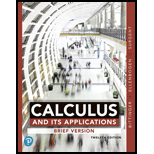
CALCULUS+ITS APPLICATIONS (LL)
12th Edition
ISBN: 9780135165928
Author: BITTINGER
Publisher: PEARSON
expand_more
expand_more
format_list_bulleted
Question
Chapter CR, Problem 23CR
To determine
Evaluate
Expert Solution & Answer
Want to see the full answer?
Check out a sample textbook solution
Students have asked these similar questions
please do Q3
Use the properties of logarithms, given that In(2) = 0.6931 and In(3) = 1.0986, to approximate the logarithm. Use a calculator to confirm your approximations. (Round your answers to four decimal places.)
(a) In(0.75)
(b) In(24)
(c) In(18)
1
(d) In
≈
2
72
Find the indefinite integral. (Remember the constant of integration.)
√tan(8x)
tan(8x) sec²(8x) dx
Chapter CR Solutions
CALCULUS+ITS APPLICATIONS (LL)
Ch. CR - Prob. 1CRCh. CR - Prob. 2CRCh. CR - Prob. 3CRCh. CR - Prob. 4CRCh. CR - Prob. 5CRCh. CR - Prob. 6CRCh. CR - Prob. 7CRCh. CR - Prob. 8CRCh. CR - Prob. 9CRCh. CR - Prob. 10CR
Ch. CR - Prob. 11CRCh. CR - Prob. 12CRCh. CR - Prob. 13CRCh. CR - Prob. 14CRCh. CR - Prob. 15CRCh. CR - Prob. 16CRCh. CR - Prob. 17CRCh. CR - Prob. 18CRCh. CR - Prob. 19CRCh. CR - Prob. 20CRCh. CR - Prob. 21CRCh. CR - Prob. 22CRCh. CR - Prob. 23CRCh. CR - Prob. 24CRCh. CR - Prob. 25CRCh. CR - Prob. 26CRCh. CR - Prob. 27CRCh. CR - Prob. 28CRCh. CR - Prob. 29CRCh. CR - Prob. 30CRCh. CR - Prob. 31CRCh. CR - Prob. 32CRCh. CR - Prob. 33CRCh. CR - Prob. 34CRCh. CR - Prob. 35CRCh. CR - Prob. 36CRCh. CR - Prob. 37CRCh. CR - Prob. 40CRCh. CR - Prob. 41CRCh. CR - Prob. 42CRCh. CR - Prob. 43CRCh. CR - Prob. 44CRCh. CR - Prob. 45CRCh. CR - Prob. 46CRCh. CR - Prob. 47CRCh. CR - Prob. 48CRCh. CR - Prob. 49CRCh. CR - Prob. 50CRCh. CR - Prob. 52CRCh. CR - Prob. 54CRCh. CR - Prob. 55CRCh. CR - Prob. 56CRCh. CR - Prob. 57CRCh. CR - Prob. 58CRCh. CR - Prob. 59CRCh. CR - Prob. 61CRCh. CR - Prob. 62CRCh. CR - Prob. 63CRCh. CR - Suppose the rate of change of y with respect to x...Ch. CR - Prob. 65CRCh. CR - Prob. 66CRCh. CR - Prob. 67CRCh. CR - Prob. 68CRCh. CR - Prob. 69CRCh. CR - Prob. 70CRCh. CR - Prob. 71CRCh. CR - Prob. 72CR
Knowledge Booster
Learn more about
Need a deep-dive on the concept behind this application? Look no further. Learn more about this topic, calculus and related others by exploring similar questions and additional content below.Similar questions
- Find the indefinite integral by making a change of variables. (Remember the constant of integration.) √(x+4) 4)√6-x dxarrow_forwarda -> f(x) = f(x) = [x] show that whether f is continuous function or not(by using theorem) Muslim_mathsarrow_forwardUse Green's Theorem to evaluate F. dr, where F = (√+4y, 2x + √√) and C consists of the arc of the curve y = 4x - x² from (0,0) to (4,0) and the line segment from (4,0) to (0,0).arrow_forward
- Evaluate F. dr where F(x, y, z) = (2yz cos(xyz), 2xzcos(xyz), 2xy cos(xyz)) and C is the line π 1 1 segment starting at the point (8, ' and ending at the point (3, 2 3'6arrow_forwardCan you help me find the result of an integral + a 炉[メをメ +炉なarrow_forward2 a Can you help me find the result of an integral a 아 x² dxarrow_forward
- Please help me with this question as I want to know how can I perform the partial fraction decompostion on this alebgric equation to find the time-domain of y(t)arrow_forwardPlease help me with this question as I want to know how can I perform the partial fraction on this alebgric equation to find the time-domain of y(t)arrow_forwardEvaluate F³ - dr where ♬ = (4z, -4y, x), and C' is given by (t) = (sin(t), t, cos(t)), 0≤t≤ñ .arrow_forward
arrow_back_ios
SEE MORE QUESTIONS
arrow_forward_ios
Recommended textbooks for you
 Algebra & Trigonometry with Analytic GeometryAlgebraISBN:9781133382119Author:SwokowskiPublisher:Cengage
Algebra & Trigonometry with Analytic GeometryAlgebraISBN:9781133382119Author:SwokowskiPublisher:Cengage Algebra: Structure And Method, Book 1AlgebraISBN:9780395977224Author:Richard G. Brown, Mary P. Dolciani, Robert H. Sorgenfrey, William L. ColePublisher:McDougal Littell
Algebra: Structure And Method, Book 1AlgebraISBN:9780395977224Author:Richard G. Brown, Mary P. Dolciani, Robert H. Sorgenfrey, William L. ColePublisher:McDougal Littell Glencoe Algebra 1, Student Edition, 9780079039897...AlgebraISBN:9780079039897Author:CarterPublisher:McGraw Hill
Glencoe Algebra 1, Student Edition, 9780079039897...AlgebraISBN:9780079039897Author:CarterPublisher:McGraw Hill Functions and Change: A Modeling Approach to Coll...AlgebraISBN:9781337111348Author:Bruce Crauder, Benny Evans, Alan NoellPublisher:Cengage Learning
Functions and Change: A Modeling Approach to Coll...AlgebraISBN:9781337111348Author:Bruce Crauder, Benny Evans, Alan NoellPublisher:Cengage Learning Algebra and Trigonometry (MindTap Course List)AlgebraISBN:9781305071742Author:James Stewart, Lothar Redlin, Saleem WatsonPublisher:Cengage Learning
Algebra and Trigonometry (MindTap Course List)AlgebraISBN:9781305071742Author:James Stewart, Lothar Redlin, Saleem WatsonPublisher:Cengage Learning


Algebra & Trigonometry with Analytic Geometry
Algebra
ISBN:9781133382119
Author:Swokowski
Publisher:Cengage

Algebra: Structure And Method, Book 1
Algebra
ISBN:9780395977224
Author:Richard G. Brown, Mary P. Dolciani, Robert H. Sorgenfrey, William L. Cole
Publisher:McDougal Littell

Glencoe Algebra 1, Student Edition, 9780079039897...
Algebra
ISBN:9780079039897
Author:Carter
Publisher:McGraw Hill

Functions and Change: A Modeling Approach to Coll...
Algebra
ISBN:9781337111348
Author:Bruce Crauder, Benny Evans, Alan Noell
Publisher:Cengage Learning

Algebra and Trigonometry (MindTap Course List)
Algebra
ISBN:9781305071742
Author:James Stewart, Lothar Redlin, Saleem Watson
Publisher:Cengage Learning
Implicit Differentiation Explained - Product Rule, Quotient & Chain Rule - Calculus; Author: The Organic Chemistry Tutor;https://www.youtube.com/watch?v=LGY-DjFsALc;License: Standard YouTube License, CC-BY